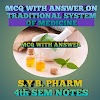S.Y B.PHARM SEMESTER III
EXPERIMENT NO. 2
AIM: - To
carry out the preparation and sterilization of nutrient agar media and
glassware’s
Reference:
-
1. Experimental Microbiology book (As Per PCI Syllabus) by Savita Mandan, Umesh Laddha, Sanjay Surana, Published by Career Publication, First edition, Page No -. 30 - 32
2. Pharmaceutical Microbiology (As Per PCI Regulation) by Prof Chandrakant Kokare, Published by Nirali Prakashan, First Edition, Page No. – AI19 - AI20.
3. Practical pharmaceutical microbiology book by Prof Rageeb, K.D Baviskar, N.G Patil, Published by S. Vikas And Company (Medical Publisher), Edition 2018, Page No 36–42.
Requirement’s: -
Apparatus:
- Conical Flask, Glass rod, Burner , Petri plate, Test tubes , Measuring
cylinder, Cotton , Autoclave, Balance Hot air oven.
Chemicals:
- Beef Extract, Peptone, Glucose, Sodium Chloride,
Agar Agar Powder
Culture
media: - Culture media is a mixture of nutrients that
supports the growth and multiplication of microbes. Nutrient media are used for cultivation of
microorganisms. Media can be prepared in three different forms viz. Solid,
liquid and semisolid. (Divided according to their consistency)
Solid (agar) media:
Solid media contain high proportion of agar which is useful for isolation of
microorganisms in the form of colonies. It is prepared by adding a solidifying
agent (agar 1.5 -3%). Prepared mainly in petri dishes, but also in tubes and
slopes. After growth the bacterial colonies are visible. e.g. Nutrient agar, blood
agar, chocolate agar, MacConkey agar.
Semi-solid agar media(soft agar): Semisolid
media contain less amount of agar (0.5-0.7%) which is useful for cultivation of
microaerophilic bacteria and for detection of motility of bacteria and also
used as a transport media for fragile organisms.
Liquidmedia (Broth): Liquid media contain absence of agar. Growth of bacteria is shown by turbidity in
medium. Liquid medium is best when you want to rapidly increase the
concentration of the organism or when you want to grow motile cells.
E.g. Nutrient broth Selenite F broth,
alkaline peptone water.
2. Synthetic or defined
media.
3. Non-synthetic or
undefined or complex media.
6. Selective media
7. Indicator media
8. Differential media
9. Sugar media
10. Transport media
11. Assay media
12. Storage media
A] PREPARATION
AND STERILIZATION OF NUTRIENT AGAR MEDIA
Principle:
- Nutrient agar is a nutrient broth
solidified by addition of agar. Solid media is prepared for isolation of pure
culture by different techniques, preservation of cultures or study of colony
characteristic of microbes.
Composition
of nutrient agar media
1. Beef
extract…….10g
2. Peptone…………10g
3. Sodium
chloride...05g
4. Distilled
water to make.... 1000 ml
5. Agar…………20g
(PH………7.0)
Procedure:
-
1)
Weigh all ingredients in proper
proportion with the help of physical balance.
2)
Add
beef extract and peptone in suitable conical flask & dissolve in
sufficient water
3) Then
it is heated on burner to dissolve all ingredients till to get clear yellow
coloured liquid.
4)
Adjust the (pH 7.0) of media using 1N
HCl or 1N NaOH.
5)
Pour the agar into conical flask and
plug it with cotton swab.
6)
Conical flask is placed in autoclave for
sterilization of media.
7)
Media is sterilized at temperature of
121 °C, at 15 lbs pressure for 15 minutes.
8)
Sterilize all glassware during the same
time.
9)
After sterilization allow it to cool at
moderate temperature and transfer to aseptic place.
10)
Disinfectant the working platform and
flame the two burners.
11)
Culture media and glassware are placed
to this aseptic area.
12)
Pour the sterilized media from conical
flask into test tube, hold the test tube in vertical position and allow it to
solidify to get agar stab.
13)
Pour the sterilized media from conical
flask into test tube, hold the test tube at inclined position and allow it to
solidify to get agar slant.
14)
Pour the sterilized media from conical
flask into petri dish allow it to solidify to get cleared solidified surface.
15)
Keep all test tubes and petri plate in
incubator.
16)
Set the incubator at 37 °C for 24 hrs.
B]
STERILIZATION OF GLASSWARE’S
Principle: All the glassware’s in pharmaceutical
laboratories are sterilized by dry heat method. Hot air oven is used for
sterilization of glassware’s. When sterilizing glassware such as bottles, petri
dishes and test tubes, the ideal temperature of the oven needs to reach is at
least 160°C and the contents need to
be regulated at this heat for 45 to 60 minutes.
Procedure: -
1. Wash
all the glassware’s, dry completely before keeping in hot air oven.
2. Glassware’s
should be placed in such way that free circulation of air is possible through glassware’s.
3. If
test tubes, flask or measuring cylinder are placed then it should be plugged
with cotton wool and covered with foil.
4. Switch
on the oven and set the temperature.
5. When
pilot lamp switch on it shows that temperature in the oven is same as set temperature which is required for sterilization.
6. Glassware’s
are placed in metal tray of hot air oven.
7. Generally
sterilization of glassware is carried out at temperature of 160 °C for two
hours,
8. Switch off the oven allow cooling and removing
glassware’s after cooling.
9. Remove
the cooled glassware’s and keep at aseptic place.
10. The contents must not be removed from the oven immediately as a slow cooling period is necessary ideally when the temperature has reduced down to 50°c, but no less. The reason for the gradual cooling period is to avoid the cracking of glassware as well as | preventing air (that could potentially contain contaminating organisms) entering the oven.
Observation and result: - Appearance of Clean, transparent, solidified surface indicates successful preparation and sterilization of nutrient agar media.














0 Comments
Please do not enter any spam link in the comment box.